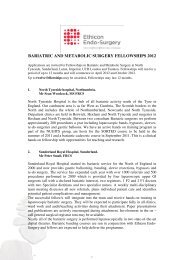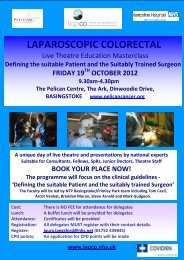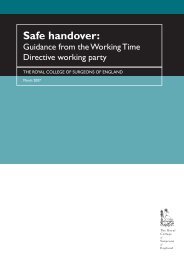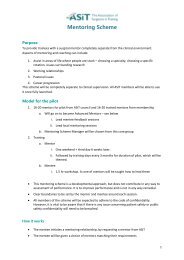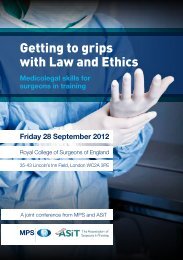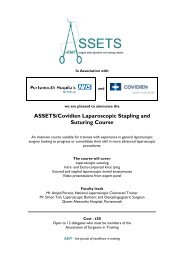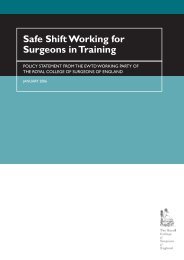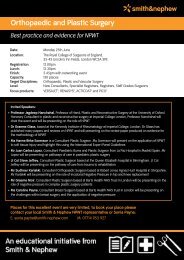ASiT Yearbook 2011 - The Association of Surgeons in Training
ASiT Yearbook 2011 - The Association of Surgeons in Training
ASiT Yearbook 2011 - The Association of Surgeons in Training
You also want an ePaper? Increase the reach of your titles
YUMPU automatically turns print PDFs into web optimized ePapers that Google loves.
Simulation-Steele 3_Layout 1 29/03/<strong>2011</strong> 12:59 Page 5<br />
evaluation <strong>of</strong> the given simulator by experts, then an<br />
evaluation <strong>of</strong> the simulator by tra<strong>in</strong>ees and if both <strong>of</strong><br />
these steps have a favourable outcome, carry<strong>in</strong>g out<br />
prospective studies on the simulator with the emphasis<br />
on transferability <strong>of</strong> simulator acquired skills <strong>in</strong>to the<br />
cl<strong>in</strong>ical situation.<br />
Only by go<strong>in</strong>g through this rigorous process can we be<br />
certa<strong>in</strong> that simulators will <strong>in</strong>deed make a significant<br />
contribution to a tra<strong>in</strong><strong>in</strong>g programme.<br />
Figure 7 - Skills centre for simulation tra<strong>in</strong><strong>in</strong>g (courtesy <strong>of</strong> the Cuschieri Skills<br />
Centre, University <strong>of</strong> Dundee)<br />
Conclusions<br />
Currently many simulators cover<strong>in</strong>g a wide range <strong>of</strong><br />
procedures and levels <strong>of</strong> complexity are available to<br />
surgical tra<strong>in</strong>ees and the recent report by the CMO <strong>in</strong><br />
England entitled ‘Safer Medical Practice, Mach<strong>in</strong>es,<br />
Manik<strong>in</strong>s and Polo M<strong>in</strong>ts’ 23 has emphasised the<br />
importance <strong>of</strong> <strong>in</strong>tegrat<strong>in</strong>g simulation <strong>in</strong>to all medical<br />
tra<strong>in</strong><strong>in</strong>g programmes. Clearly some specialties will<br />
benefit more from simulation than others but it is fair to<br />
say that all surgical tra<strong>in</strong><strong>in</strong>g programmes have the<br />
potential to be enhanced by a considered <strong>in</strong>troduction<br />
<strong>of</strong> simulation. However, at present, tra<strong>in</strong>ees are faced<br />
with a bewilder<strong>in</strong>g array <strong>of</strong> possibilities, many <strong>of</strong> them<br />
expensive, with little guidance as to what is truly<br />
beneficial. It should also be emphasised that, <strong>in</strong> surgery,<br />
simulation has focussed on specific technical skills and<br />
yet it has been recognised for many years that nontechnical<br />
(human) factors have an effect on outcome<br />
that outweighs that <strong>of</strong> purely technical ability 24 . Despite<br />
this, simulation <strong>of</strong> decision mak<strong>in</strong>g and the <strong>in</strong>tegration <strong>of</strong><br />
technical and non-technical skills has yet to f<strong>in</strong>d its place<br />
<strong>in</strong> surgical tra<strong>in</strong><strong>in</strong>g schemes.<br />
In surgery, if the CMO’s vision is to be translated <strong>in</strong>to<br />
reality, it is essential that tra<strong>in</strong><strong>in</strong>g programmes are<br />
developed where simulation is <strong>in</strong>corporated appropriately.<br />
Such simulation must be <strong>of</strong> the highest quality,<br />
and given the expense <strong>of</strong> the more sophisticated<br />
simulators, the only sensible approach is to concentrate<br />
high-level simulation <strong>in</strong> state-<strong>of</strong>-the-art centres (figure 7).<br />
Hav<strong>in</strong>g a simulator <strong>in</strong> every hospital might seem to be a<br />
laudable aim, but other than simple gadgets or boxes to<br />
allow junior tra<strong>in</strong>ees to hone basic skills, this is neither<br />
feasible nor useful. It must also be recognised that<br />
<strong>in</strong>troduc<strong>in</strong>g simulation <strong>in</strong> a co-ord<strong>in</strong>ated and beneficial<br />
manner will require a multi-discipl<strong>in</strong>ary approach<br />
<strong>in</strong>volv<strong>in</strong>g expert surgeons, tra<strong>in</strong>ees, educationalists,<br />
simulation designers and programme directors work<strong>in</strong>g<br />
together to ensure that a rational, affordable syllabus <strong>of</strong><br />
simulation tra<strong>in</strong><strong>in</strong>g is developed and <strong>in</strong>tegrated <strong>in</strong>to<br />
tra<strong>in</strong><strong>in</strong>g programmes.<br />
References<br />
1 Bradley P. <strong>The</strong> history <strong>of</strong> simulation <strong>in</strong> medical education and<br />
possible future directions. Medical education. 2006; 40: 254-62<br />
2 Satava RM. Historical review <strong>of</strong> surgical simulation - a personal<br />
perspective. World J Surg 2008; 32: 141-8<br />
3 Bradley P, Bligh J. Cl<strong>in</strong>ical skills centres: where are we go<strong>in</strong>g?<br />
Medical Education 2005; 39: 649-650<br />
4 Kneebone R. Simulation <strong>in</strong> surgical tra<strong>in</strong><strong>in</strong>g : educational issues<br />
and practical implications. Medical Eucation 2003; 37: 267-77<br />
5 Steele RJC, Hosk<strong>in</strong>g S, Chung SCS. Graded exercises for basic<br />
tra<strong>in</strong><strong>in</strong>g <strong>in</strong> laparoscopic surgery. J Roy Coll Surg Ed<strong>in</strong> 1994; 39:<br />
112 117<br />
6 de Boer PG, Buckley R, Schmidt P, Fox R, Jupiter J. Learn<strong>in</strong>g<br />
assessment toolkit. J Bone Jo<strong>in</strong>t Surg Am 2010; 92: 1325-1329<br />
7 Cunn<strong>in</strong>gham M, Fernando B, Berl<strong>in</strong>gieri P. <strong>The</strong> emerg<strong>in</strong>g role <strong>of</strong><br />
screen based simulators <strong>in</strong> the tra<strong>in</strong><strong>in</strong>g and assessment <strong>of</strong><br />
colonocopists. Frontl<strong>in</strong>e Gastroenterology 2010; 1: 76-81<br />
8 Helmreich R, Schaeffer H. Turn<strong>in</strong>g silk purses <strong>in</strong>to sow’s ears;<br />
human factors <strong>in</strong> medic<strong>in</strong>e. In: Hanson L, Lee A editors.<br />
Simulation <strong>in</strong> anaesthesia education. New York: Plenum; 1998;<br />
1-8<br />
9 Thiel W. <strong>The</strong> preservation <strong>of</strong> the whole corpse with natural<br />
colour. Ann Anat 1992; 174: 185-195<br />
10 Macdonald GJ, MacGregor DB. Procedures for embalm<strong>in</strong>g<br />
cadavers for the dissection laboratory. Proc Sco Exp Biol Med<br />
1997; 215: 363-365<br />
11 Seymour NE. VR to OR: a review <strong>of</strong> the evidence that virtual<br />
reality simulation improves operat<strong>in</strong>g room performance. World<br />
J Surg 2008; 32: 182-188<br />
12 Knoll T, Trojan L, Haeker A, Alken P, Michel MS. Validation <strong>of</strong><br />
computer-based tra<strong>in</strong><strong>in</strong>g <strong>in</strong> ureteroendosopy. BJU Int 2005; 95:<br />
1276-1279<br />
13 Ahlberg G, Enochsson L, Gallagher AG, et al. Pr<strong>of</strong>iciency-based<br />
virtual reality tra<strong>in</strong><strong>in</strong>g significantly reduces the error rate for<br />
residents dur<strong>in</strong>g their first 10 laparoscopic cholecystectomies.<br />
Am J Surg 2007; 193: 797-804<br />
14 Grantcharov TP, Kristiansen VB, Bendix J, Bardram L,<br />
Rosenberg J, Funch-Jensen P. Randomized cl<strong>in</strong>ical trial <strong>of</strong> virtual<br />
reality simulation for laparoscopic skills tra<strong>in</strong><strong>in</strong>g. Br J Surg 2004;<br />
91: 146-150<br />
15 Park Jl, MacRae H, Musselman LJ, et al. Randomized controlled<br />
trial <strong>of</strong> virtual reality simulator tra<strong>in</strong><strong>in</strong>g: transfer to live patients.<br />
Am J Surg 2007; 194: 205-211<br />
16 Schijven MP, Jakimowicz JJ, Broeders IA, Tseng LN. <strong>The</strong><br />
E<strong>in</strong>dhoven laparoscopic tra<strong>in</strong><strong>in</strong>g course - improv<strong>in</strong>g operat<strong>in</strong>g<br />
room performance us<strong>in</strong>g virtual reality tra<strong>in</strong><strong>in</strong>g; results form the<br />
first EAES accredited virtual reality tra<strong>in</strong><strong>in</strong>g curriculum. Surg<br />
Endosc 2005; 19: 1220-1229<br />
17 van Hove PD, Tuijth<strong>of</strong> GJM, Verdaasdonk EGG, Stassen LPS,<br />
Dankelman J. Objective assessment <strong>of</strong> technical surgical skills.<br />
Br J Surg 2010; 97: 972-987<br />
<strong>ASiT</strong> - the pursuit <strong>of</strong> excellence <strong>in</strong> tra<strong>in</strong><strong>in</strong>g 3<br />
STUDENTS<br />
SCIENTIFIC TRAINING & CAREERS POLITICAL PORTFOLIO <strong>ASiT</strong> COUNCIL <strong>ASiT</strong> EXECUTIVE



